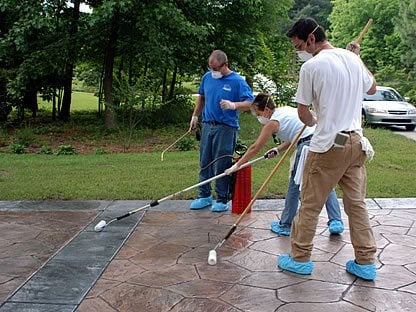- Concrete Maitenance Home
- Cleaning and Sealing Exterior Concrete: A Guide to Maintaining and Caring for Exterior Decorative Concrete of All Types
- Sealing Plain Concrete
- Sealing Colored Concrete
- Sealing Exposed Aggregate Concrete
- Sealing Joints
- Tips for Cleaning Exterior Concrete
- How to Maintain Concrete Floors
- Six Common Questions about Concrete Floor Sealers
- Protecting Acid-Stained Floors
- Watch Videos on Maintaining and Sealing Concrete Floors, with Bob Harris
- How to Maintain Concrete Countertops
- Countertop Sealer Overview: Which Sealer is Best For Your Countertop?
- Related Information:
- Concrete Sealer Information
- Comparison Chart of Concrete Sealers
- Advice on Choosing and Applying Concrete Sealers, from Technical Expert Chris Sullivan
How to Seal Concrete in 7 Steps
Tips for applying concrete sealer properly, including when to seal, how many coats and dry time
A crew applies concrete sealer to a stamped driveway using a sprayer and rollers. Decorative Concrete Institute
Concrete sealers protect your concrete from weather exposure, water, grease and oil stains, abrasion and deicing salts. They also help bring out the natural beauty of your concrete and make it easier to clean. But in order for a sealer to work, it must be applied properly. Each step will have an impact on the final outcome. Following are some tips for applying concrete sealer properly.
Here’s a step-by-step summary of how to seal concrete:
- Remove all oil, grease, stains, dirt, and dust from the concrete
- Strip any existing sealer from the surface
- Open up the concrete with an etching solution
- Apply a thin coat of sealer using a roller or sprayer
- Wait for the first layer of sealer to dry
- Apply a second coat in the opposite direction
- Allow the sealer to fully dry before walking or driving on your concrete
While many homeowners attempt to seal their own concrete, it can be trickier than you think. To ensure it is done properly, hire a concrete contractor near you. If you know who originally worked on your concrete, they may offer a maintenance package that includes sealing every few years.
Note: Whichever brand of sealer you use, be sure to follow the specific instructions recommended by the product manufacturer, since they may differ from the general guidelines given here. Find the best concrete sealer for your project.
 Deep Penetrating Sealer
RadonSeal - Waterproofs & strengthens.
Deep Penetrating Sealer
RadonSeal - Waterproofs & strengthens.
 Decorative Sealers
Reactive and penetrating formulas in various levels of gloss.
Decorative Sealers
Reactive and penetrating formulas in various levels of gloss.
 Water Repellent Penetrating
Sealer for driveways, parking structures, plazas, walkways & more.
Water Repellent Penetrating
Sealer for driveways, parking structures, plazas, walkways & more.
 Penetrating Concrete Sealer
$179.95 (5 gal.)
Penetrating Concrete Sealer
$179.95 (5 gal.)
 Clear-Seal by Increte Systems
Seals and protects exterior surfaces.
Clear-Seal by Increte Systems
Seals and protects exterior surfaces.
 Gem-Guard SB
Penetrating sealer that protects against salt damage
Gem-Guard SB
Penetrating sealer that protects against salt damage
When to seal concrete
When you apply sealer can be important as well. Here are some guidelines:
- Allow new concrete to cure completely (at least 28 days or as recommended).
- Most sealers must be applied under dry conditions. Applying to damp concrete could cause haziness or loss of adhesion.
- Air temperatures should be above 50°F during sealer application and for at least 24 hours after.
Preparing concrete for sealing
Surface preparation before applying a sealer to existing concrete is extremely important. All oil, grease, stains, dirt, and dust must be removed or they may prevent the sealer from adhering properly. Also, if a sealer is being applied over a different brand of sealer, most manufacturers advise removing all traces of previously used sealers, since the products may not be compatible. Some manufacturers recommend etching the surface first with an etching solution to ensure the best adhesion. (See Cleaning Concrete.)
How to apply concrete sealer
Using the right tools is critical to achieving the best coverage rate and sealer thickness for optimal performance. The two most common methods of applying sealers to concrete surfaces are by roller or sprayer, often depending on whether the sealer is solvent- or water-based. Always refer to the manufacturer's specific application guidelines. (See Choosing the Best Sealer Applicator.)
Whether you are rolling or spray applying a sealer, always strive for maximum coverage. The typical coverage rate is 250 to 300 square feet per gallon, depending on the porosity of the concrete.
How many coats of concrete sealer?
The most important rule to remember is that less is more. It's best to apply two thin coats, making sure the sealer doesn't puddle or form uneven, thick areas. When applying a second coat of sealer, apply it in the opposite direction (or perpendicular) to the first coat to ensure even coverage. Wait to apply the second coat of sealer for the time recommended by the manufacturer (typically two to four hours).
Concrete sealer dry time
Always allow the sealer to dry completely before exposing it to foot or vehicle traffic. Drying times before exposure to heavy traffic can be as long as three days.
Related Resources:
Driveway Sealer for Concrete: How to Apply and Buying Tips




